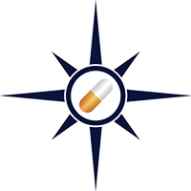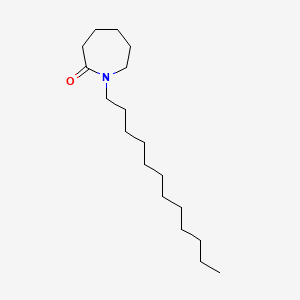



1. 1-dodecylazacycloheptan-2-one
2. 1-dodecylhexahydro-2h-azepin-2-one
3. Azone
1. 59227-89-3
2. N-dodecylcaprolactam
3. 1-dodecylazepan-2-one
4. Azone
5. Tranzone
6. 1-dodecylazacycloheptan-2-one
7. 2h-azepin-2-one, 1-dodecylhexahydro-
8. N-lauryl Caprolactam
9. 1-dodecylhexahydro-2h-azepin-2-one
10. N-0252
11. 1-n-dodecylazacycloheptan-2-one
12. 1f3x9drv9x
13. N-dodecyl-.epsilon.-caprolactam
14. Laurocapramum [latin]
15. Caswell No. 064a
16. Laurocapramum
17. Laurocapram [usan:inn]
18. Usaf Nd-72
19. 1-dodecyl-2-azepanone
20. Einecs 261-668-9
21. Unii-1f3x9drv9x
22. Brn 0167211
23. Trazone
24. Hsdb 7660
25. Laurocapram,(s)
26. N 0252
27. N-n-dodecylcaprolactam
28. Laurocapram [mi]
29. Laurocapram [inn]
30. Laurocapram (usan/inn)
31. Laurocapram [hsdb]
32. Laurocapram [inci]
33. Laurocapram [usan]
34. 2h-azepin-2-one, Hexahydro-n-lauryl-
35. Laurocapram (water Soluble)
36. Dsstox_cid_22086
37. Dsstox_rid_79921
38. Laurocapram [mart.]
39. Dsstox_gsid_42086
40. Schembl23347
41. N-dodecyl-epsilon-caprolactam
42. 4-21-00-03206 (beilstein Handbook Reference)
43. Chembl76591
44. 1-dodecylazacycloheptane-2-one
45. Dtxsid0042086
46. 1-dodecyl-2-azepanone, Aldrichcpr
47. Bcp10858
48. Zinc8214596
49. Tox21_301757
50. Mfcd00190580
51. S4841
52. Stl320722
53. Akos015843226
54. Ccg-267257
55. Cs-w010042
56. Hy-w009326
57. Ks-5054
58. Ncgc00255788-01
59. Ac-11681
60. Cas-59227-89-3
61. Db-053343
62. Ft-0627723
63. L0317
64. D04678
65. 227l893
66. A832216
67. Sr-01000944876
68. Q-201282
69. Sr-01000944876-1
70. Q27252353
71. Laurocapram; Azon; Azone; 1-dodecylazacycloheptan-2-one; N-dodecylcaprolactam; 1-dodecylhexahydro-2h-azepin-2-one
| Molecular Weight | 281.5 g/mol |
|---|---|
| Molecular Formula | C18H35NO |
| XLogP3 | 5.9 |
| Hydrogen Bond Donor Count | 0 |
| Hydrogen Bond Acceptor Count | 1 |
| Rotatable Bond Count | 11 |
| Exact Mass | 281.271864740 g/mol |
| Monoisotopic Mass | 281.271864740 g/mol |
| Topological Polar Surface Area | 20.3 Ų |
| Heavy Atom Count | 20 |
| Formal Charge | 0 |
| Complexity | 240 |
| Isotope Atom Count | 0 |
| Defined Atom Stereocenter Count | 0 |
| Undefined Atom Stereocenter Count | 0 |
| Defined Bond Stereocenter Count | 0 |
| Undefined Bond Stereocenter Count | 0 |
| Covalently Bonded Unit Count | 1 |
1-Dodecylazacycloheptan-2-one (Azone) is a new agent that enhances the percutaneous absorption of a number of different chemicals. This report delineates the enhancement of penetration of clindamycin phosphate, erythromycin base, fusidate sodium, fluorouracil, desonide, amcinonide, and triamcinolone acetonide. For this purpose 1-dodecylazacycloheptan-2-one can be used in concentrations as low as 1%. It is colorless, relatively odorless, nontoxic, and can be applied neat to human skin without any irritation.
PMID:7092271 Stoughton RB; Arch Dermatol 118 (7): 474-7 (1982)
/EXP THER/ To assess the safety and tolerability of a topical gel formulation combining methotrexate and laurocapram and to obtain preliminary information on the therapeutic potential of methotrexate-laurocapram in patients with early-stage mycosis fungoides (stage IA or IB). An open-label, phase 1/2 pilot study /was conducted/. ...Ten patients 18 years or older with histologically confirmed stage IA or IB mycosis fungoides. ... The gel formulation of methotrexate-laurocapram was applied to the total body surface, excluding genital, perianal areas, nipples, face, and skin under the breasts, on an every-other-day basis for 24 consecutive weeks. The safety of methotrexate-laurocapram was assessed in this study by reviewing adverse events and laboratory data. Efficacy outcomes included changes in lesion condition and severity assessments, reduction in area of sample lesions, and the investigator's global evaluation. Adverse events consisted of skin reactions of mild severity. No clinically significant laboratory abnormalities were observed. Based on the investigator's global evaluation at the end of the treatment phase (week 24), 7 (78%) of 9 patients demonstrated a slight-to-moderate response to treatment with methotrexate-laurocapram. Statistical significance (P =.049) was reached for induration and pruritus, a trend (P =.10) was observed for erythema, and no change was found for scaling (P =.37). These findings indicate that the topical administration of methotrexate-laurocapram is safe and in general well tolerated. This treatment may represent a new therapeutic potential for patients with mycosis fungoides.
PMID:12756099 Demierre MF et al; Arch Dermatol 139 (5): 624-8 (2003)
Azone (1-dodecylazacycloheptan-2-one) is an agent that has been shown to enhance percutaneous absorption of drugs. Azone is thought to act by partitioning into skin lipid bilayers and thereby disrupting the structure. An open-label study was done with nine volunteers (two males, seven females; aged 51-76 years) in which Azone cream (1.6%; 100 mg) was topically dosed on a 5 x 10-cm area of the ventral forearm for 21 consecutive days. On days 1, 8, and 15, the Azone cream contained 47 uCi of (14)C Azone. The skin application site was washed with soap and water after each 24-hr dosing. Percutaneous absorption was determined by urinary radioactivity excretion. The (14)C Azone was ring labeled [14C-2-cyclo-heptan]. Radiochemical purity was >98.6% and cold Azone purity was 99%. Percutaneous absorption of the first dose (day 1) was 1.84 +/- 1.56% (SD) of applied dose for 24-hr skin application time. Day 8 percutaneous absorption, after repeated application, increased significantly (p<0.002) to 2.76 +/- 1.91%. Day 15 percutaneous absorption, after continued repeated application, stayed the same at 2.72 +/- 1.21%. In humans, repeated application of Azone results in an initial self-absorption enhancement, probably due to its mechanism of action. However, steady-state percutaneous absorption of Azone is established after this initial change. Thus, Azone can enhance its own absorption as well as that of other compounds. This should be considered relevant for any pharmacological or toxicological evaluation. Washing the skin site of application with soap and water only recovered 1-2% of applied radioactivity. Previous published studies recovered the Azone dose with ethanol washes. Thus, there could potentially be an accumulation of Azone in skin.
PMID:8169776 Wester RC et al; J Pharm Sci 83 (2): 124-5 (1994)
Absorption enhancers are substances used for temporarily increasing a membrane's permeability (e.g., the skin and mucosa), either by interacting with its components (lipids or proteins) or by increasing the membrane/vehicle partition coefficient. ... The enhancing effect of Laurocapram (Azone) is attributed to different mechanisms, such as insertion of its dodecyl group into the intercellular lipidic bilayer, increase of the motion of the alkylic chains of lipids, and fluidization of the hydrophobic regions of the lamellate structure. ...
PMID:16556532 Lopez-Cervantes M et al; Drug Dev Ind Pharm 32 (3): 267-86 (2006)